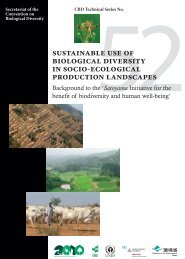INDIAN SCIENCE CONGRESS - India Environment Portal
INDIAN SCIENCE CONGRESS - India Environment Portal
INDIAN SCIENCE CONGRESS - India Environment Portal
Create successful ePaper yourself
Turn your PDF publications into a flip-book with our unique Google optimized e-Paper software.
46<br />
Proc. 98th <strong>India</strong>n Science Congress, Part II : Abstracts of Oral/Poster Presentation<br />
in the form of characteristic small circular, brown coloured patches on the surface<br />
of leaves and these brownish patches grow in size and coalesced to cover the entire<br />
surface of leaves producing blight symptoms. Marked blight symptoms are seen in<br />
the head (capitulum) of heavily infected plants in which seeds are also infected with<br />
Alternaria helianthi. Naturally infected seeds with A. helianthi and artificially<br />
inoculated one showed 38. 6% and 23. 0% reduction in germination respectively.<br />
Shoot and root length of seedlings was also significantly reduced in both cases.<br />
There was a marked increase in number of seedlings showing blight incidence with<br />
increase in spore load of A. helianthi on seeds. Biocontrol of Alternaria blight by<br />
selected natural herbal plant extracts in-vitro has been observed and recommended<br />
for use to the farmers.<br />
59. In vitro Evaluation of Phytoextracts and Fungicides for Curvularia<br />
Lunata<br />
Ashwani Tapwal 1 , Upender Singh 2 , Gurpreet Singh 2 ,<br />
Nandini Gautam 2 and Rajesh Kumar 1<br />
1 Rain Forest Research Institute,<br />
P. B. 136, Deovan,<br />
Jorhat, Assam<br />
2 Shoolini Institute of Life Sciences and Business Management,<br />
Anand Campus, The Mall Solan, HP<br />
Keywords : Curvularia lunata, botanicals, fungicides, IPM<br />
Fungal diseases are serious threats to the plant kingdom and sometime they<br />
cause a heavy mortality in nurseries and field. The genus Curvularia include a<br />
group of phramosporus dematiaceae in which most distinguishing character is the<br />
disproportionately large middle cell or cells of the conidium. C. lunata is very<br />
important pathogens having wide host range infecting grasses, cereals and forest<br />
species. These diseases are often very difficult to control and some losses can<br />
usually be expected during each seedling crop. At present, quick and effective<br />
management of plant diseases is generally achieved by the use of synthetic<br />
pesticides but it is very expensive and also not an environment friendly approach.<br />
The need of hour is to minimize the use of synthetic pesticides by encouraging the
















